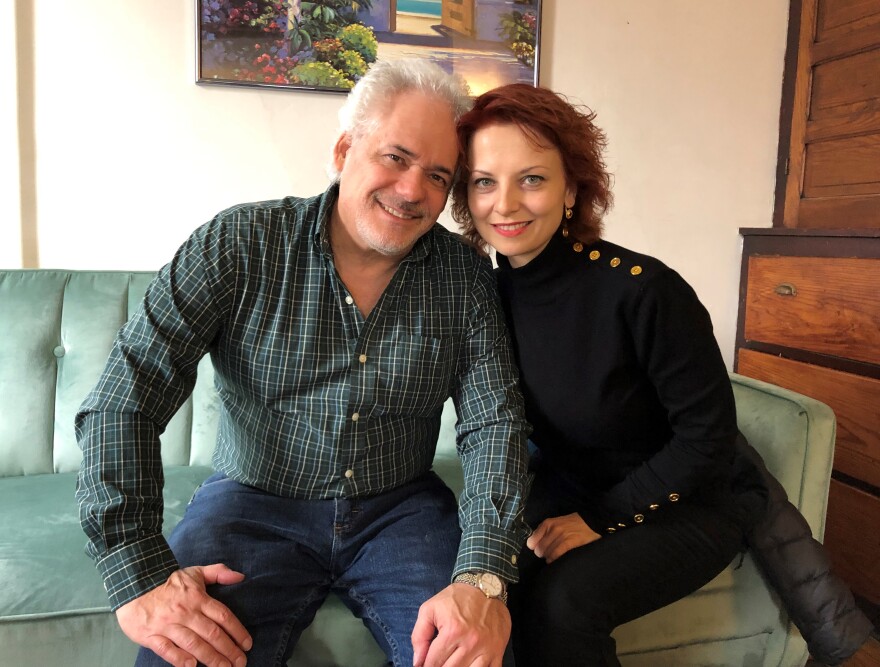America has a long tradition of the lone inventor, and Ohio has long been a leader in aerospace innovation.
An inventor in Oberlin combines the two by creating a new form of aircraft in his backyard.
On this week’s Exploradio, we look at the quest for a flying machine with no moving parts.
I first met Ethan Krauss in 2019 at his home in Oberlin.
His wife Elena Loskova, a pianist at the Oberlin Conservatory of Music, served tea as we perused his photo album of failed flying machines, a compendium of discarded experiments on the path to a working model.
Krauss, himself a musician, has a degree in electrical engineering from Cleveland State University, but he now works nearly full-time on his decade’s long dream of ion-powered flight.

His quest was inspired by a video he found on the web.
It’s a news reel from 1964 of a craft invented by aviation pioneer Alexander de Seversky.
The British Pathe announcer intones, “The bizarre looking flying machine, which was six years in development, gets its power to move and stay aloft by ionic emissions…”
In the video, Seversky's craft, a seeming jumble of sticks and wires, levitates in the air while he manipulates controls from amid a stack of huge boxes.
“Those are the power supplies,” said Krauss, which he believes likely weighed hundreds of pounds.
It raised a question for Krauss that continues to haunt him. “Can you make a thing fly with no moving parts?”
The first ever self-contained ion powered craft
Krauss tested hundreds of configurations on his path to self-contained ion powered flight, gradually downsizing the power components so that they could be carried aloft.
“I went from a car battery, really heavy boxes like Seversky had," he said, "to these tiny things that weight nothing.”
It took about a decade of work for Krauss to build the first ever ion craft that could fly with the power supply onboard instead of tethered to a battery on the ground.
In 2014 he was awarded a patent for his design.
We head out to a small shed in Krauss’s back yard to see it in action.
The invention sits on a round table about four feet across, nearly filling the shed.

It looks, to the untrained eye, like a six-sided, metal and wire spider web.
He powers it up. It stiffens slightly.
But sadly, it doesn’t fly.
Krauss says recent adjustments to the machine, like adding a steering mechanism, have short-circuited the power supply.
“I have to rewind the transformer,” he said, among other painstaking repairs.
It’ll be another seven months before Krauss is ready for another demonstration.
MIT takes the lead
In the meantime, I spoke to electrical engineer David Perreault who’s part of a team at MIT that’s designing their own ion-powered flying machine.
He explains how the technology works.
"First, you need to take the neutral molecules in the air and essentially rip them apart and create ions.”
That requires extremely high-voltage and low-current electricity, along with a gap for the ions to jump across.
Perreault said, “an electric field accelerates those ions, which then generates thrust for the vehicle.”
It’s called ‘ionic wind’, the sort of power that invokes images of Star Wars.
Perreault says MIT’s ion-powered plane could be a silent addition to the flocks of drones he predicts we’ll see flying above cities a decade from now.
He has encouraging words for backyard inventors like Ethan Krauss, “What people have accomplished from a hobbyist perspective has been quite impressive.”
Actually Krauss’s passion for ion flight is more than a hobby, it’s an all-consuming obsession.
Ionic lift off
We’re back in Oberlin, in his shed, for another demonstration.
“All these parts," Krauss said referring to the miniturized onboard power supply and converters, "I’ve figured out a way to make them run cool and more efficient.”

Discarded electrical components, like the husks of dead flies, surround the flying machine in the center of the room, the debris of endless tinkering.
“Flight number two," he announced as I fumbled with my recorder, "…ready?"
"Yeah,” I said.
And with a barely audible crackle the spider web craft lifts off the table and hovers in the air for half a minute, before the battery dies.
“These batteries are five years old,” lamented Krauss.
It’s enough for me to verify that he has indeed achieved self-contained ion-powered flight, which was never really in doubt.
He’s posted a video of an earlier, impressive two minute flight on YouTube.
https://www.youtube.com/watch?v=Qdg0_hjuksQ
Where it will go? Nobody knows
The craft is exceedingly fragile and highly impractical, but Krauss has dreams for his invention, perhaps in outer space.
“If you hook a solar panel onto this thing," he said, "it will just run and run as long as the sun shines.”
Really though, practical applications are not what drives Ethan Krauss.
“It’s mainly me doing experiments and failing thousands and thousands of time," he said, "and every once in a while, one works.”
That's the life of the lone inventor.









